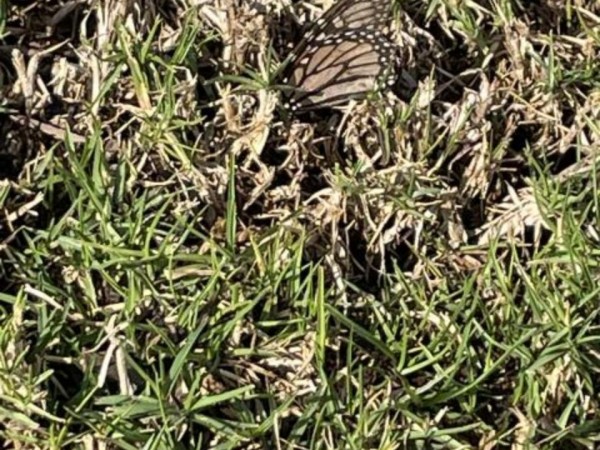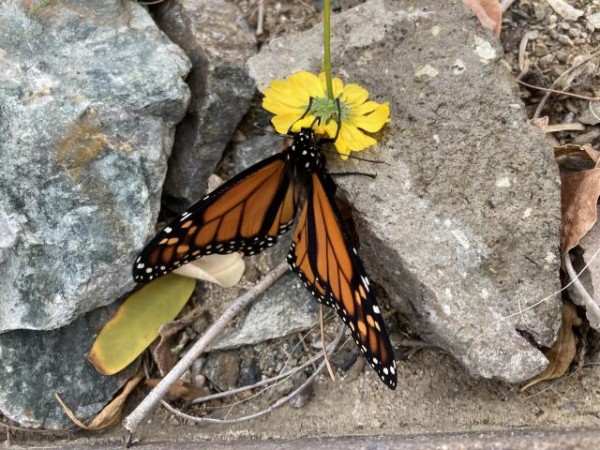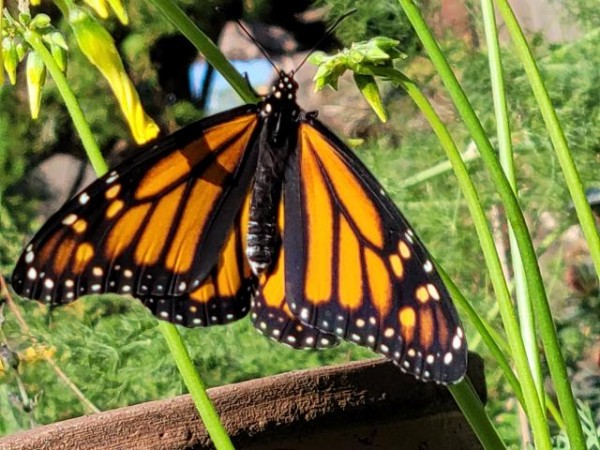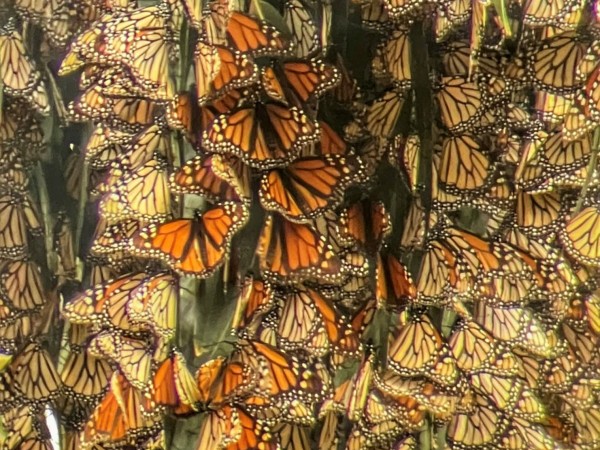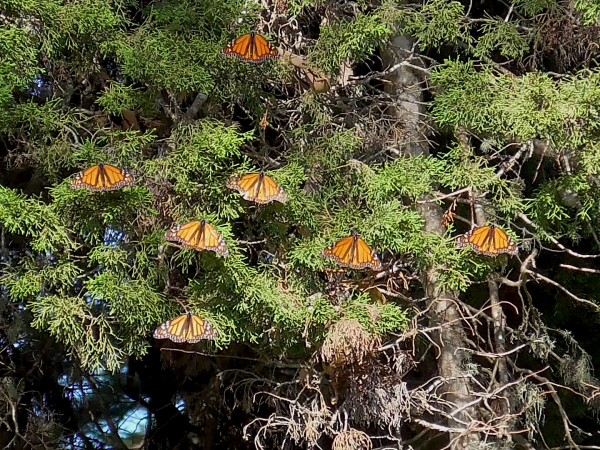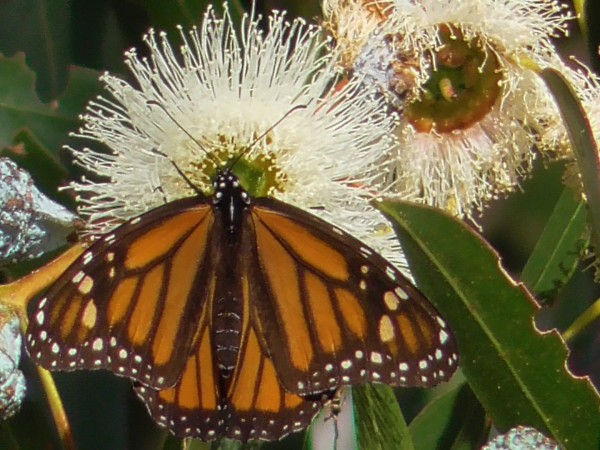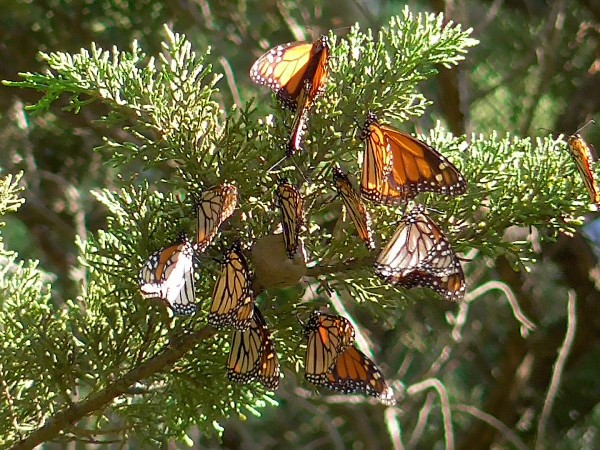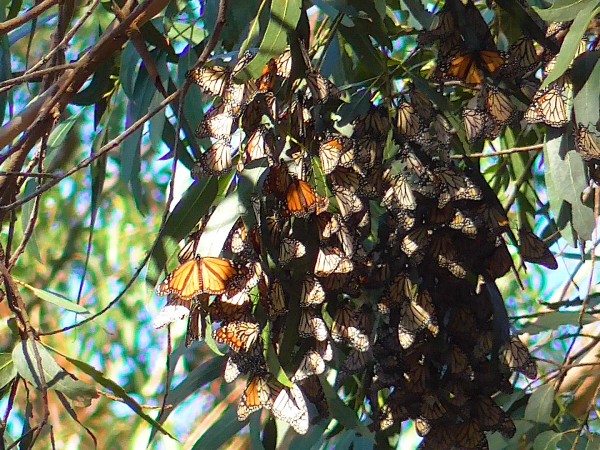Letter from Gail Morris: Western Monarch Winter 2021–22 Report #4
Published: 01/26/2022
Dear Western Monarch Friends,
Signs of monarch mating are appearing in more California overwintering sites and monarchs are becoming more active as well. Yet site numbers are still indicating many monarchs are still staying in the region around the groves, a safe harbor this time of year. Other parts of California and Southern Arizona are reporting a few fresh and new monarchs as well. Be sure to read about all the monarch activity reported by Community Scientists in the field – it’s been a busy week!
Western Monarch Sightings
Monarchs were reported in the California coastal regions and Arizona lower elevation deserts this week.
Donald reported one monarch “Flying in area” on January 14 from Rancho Palos Verdes, California. From the photo Donald submitted, can you see what this monarch is doing? Taking a few moments to reflect on how monarch activity this time of year can offer us some insights. Could this monarch be sipping dew?
Susan found 150 monarchs in Hermosa Beach, California. “A light rain 9:30 AM, Hermosa Beach California near City Hall, hanging in groups of at least 25, 6-7 groups 25-30 feet high in one tall pine tree.”
On January 15 Heather spotted one monarch in Phoenix, Arizona. Be sure to see her photo with a monarch on a rock on the ground. “This butterfly is very lethargic - I put a flower near it and it drank the nectar and holding tight to the flower but barely moving…” Why? Think of what could cause this. Look at the condition of the wings – does it look like a new monarch or an older one? Could temperature be a factor? In the desert early morning temperatures are quite chilly in the low 40’s to near 50 degrees.
Bea found a monarch in Palo Alto, California, on January 19. “Looks to be a female near some milkweed where there are caterpillars.” Look at the wing condition. Could this female have recently eclosed in January?
California Overwintering Site Monarchs
Pismo Beach
Marylou Gooden offers us an overview of monarch activity at Pismo Beach, California this week. “The current population at the Pismo Monarch Grove is 17,900, down from a high of 22,700 in November. They are still primarily concentrated in one area of the grove, but are becoming more active, and expanding their range, especially on warm and sunny days. We’ve observed sporadic mating all winter long, but more frequent mating this past week. Two winter storms with heavy rainfall had surprisingly little effect on the clusters. It is a true joy to visit the grove this winter after the bleak numbers of the three previous seasons.” Be sure to see the amazing clusters of monarchs at Pismo Beach that she provided!
Pacific Grove
Stephanie Turcotte shared the changing monarch behavior at Pacific Grove this week. “We conducted our official monarch count in Pacific Grove this morning, despite the temps warming up early and a race to beat the light hitting them. We had some near misses with branches that we had just counted, minutes later ‘bursting’.
“They have definitely reconfigured themselves. The concentrations of them dispersed much higher across the canopies of the Monterey Pine trees. The Monterey Pine #28, we dubbed ‘Charlie Brown,’ which hosted at least 5,000 monarchs on 1/7’s count, only has 56 monarchs clustered on it now!
“We did find a few small clusters on the back side of the Eucalyptus on southern end of the sanctuary along the fence line of the neighbor’s yard. The monarchs haven’t been there all season. Approx. 2,000 are clustered between 3 Monterey Pines along the visitor path. They had moved from these trees in mid-November and hadn’t been back there until last week. While there, we experienced multiple bursts of monarchs some tallying 20 and then later in the morning 100-200 monarchs!
“I also observed a few mating rituals, including ‘zig/zag chasing,’ capture, and even a pair on the ground with a failed attempt of the male trying to clasp on. Total number: 7,756.”
When the monarchs leave the grove during warm days does she think they are returned in the evening? Stephanie answered, “It is hard to know if they are leaving for good when they are active or if they are just beginning to venture out further from the grove to gather nectar. The continued counting will help tell that story. I only saw a few displays and attempts at mating. However, I left around 10:30am and who knows how much more went on after that. I will be in the sanctuary quite a bit next week with school groups so I’ll get a good gauge of how things are changing.”
Santa Cruz
Diana Magor in Santa Cruz, California, sends in some really hopeful news! One of the urgent needs in Spring as monarchs begin to leave the groves is native milkweeds in the many expanses of land they fly during their migration. We are always hoping monarchs will stay in the safety of their groves as long as possible so their migration flight and early emerging milkweed will be synchronized to offer the best opportunity for the population expand. Diana noted some early favorable indicators. “FYI, Asclepias californica is popping up in Mariposa and Yuba City already! Really good news! Maybe the migrating monarchs will find something to lay eggs on after all.” There are several conservation efforts in place to plant more A. californica to support this early phase of their Spring movement that will become more apparent in the coming weeks.
Be sure to enjoy the photos of monarchs by Robert Pacelli when he visited Natural Bridges State Park and Lighthouse Fields in Santa Cruz, California, this week.
Arizona Winter Monarchs
Monarch activity wasn’t limited to only California this month! About two weeks ago, we learned about monarchs in Green Valley, Arizona. We reached out to Jim who recently reported monarchs to Journey North and lives nearby to see what he could find. Here is his experience.
“I arrived at the La Posada Garden at 10 am and was still 54 degrees and overcast w/ only filtered sunlight. I spent 2 solid hours looking carefully in the trees for monarchs. There are 20 – 25 live oak trees that are 20 – 30 feet tall still with heavy foliage. They could be anywhere. There were also many other tree species mixed in. I thought I would be able to see them roosting against the clouded sky as I walked around but did not see them.
“Then at 12:00 noon the clouds cleared out and temp jumped to 62 degrees – on way to 66 while I was there. All of a sudden, they were everywhere and they appeared to be roosting in head height vegetation at one end of the garden. I saw two monarchs float off and leave the garden completely. Then had 3 males conduct a social spiral until they figured out who was who, and also this tired female ovipositing on one A. subulata plant at 12:30 pm. She tried 4 times to lay eggs and I could not get close enough to see. Afterwards she landed on Astro turf grass and rested. The picture of the male on the tree: This was his resting spot and anything that moved past him got challenged. Saw at least 10 Queens as well. Earlier this past week, temps went down to at least 27 deg, according to thermometer at my house, I am approximately 100 feet higher than La Posada. I found over 20 very healthy A. subulata plants at the garden. All of the flowers had been frozen back (crispy) on all these plants. I looked carefully for larvae way down at base of the plants and found none. There were a lot of lavender lantanas sprinkled everywhere and the flowers were all frozen back w exception of 1 or two that were sheltered. Was definitely surprised to find the Monarchs.” What an exciting encounter!
Thank You!
A special Thank You to Marylou Gooden, Diana Magor, Robert Pacelli, Stephanie Turcotte and Jim from Green Valley, Arizona, for their detailed reports and photographs as well as everyone who submitted sightings this week.
Winter Monarch Sightings Are Important!
Where are monarchs this winter? If you are seeing monarchs, be sure to report to Journey North whether they are adults or eggs or larvae. Provide as much information as you can such as weather conditions (it’s okay to estimate). Your detailed description of what you see can include, but is not limited to, the monarch’s gender and activity and, if known, the type of flowers if they are nectaring. If you can, observe the condition of the wings – are they fresh and new or worn and tattered or something in between – helps us learn more about monarch age and survival. We realize it isn’t always possible, but please take a photo if you can. Thanks so much for your help.
Gail Morris is the Coordinator of the Southwest Monarch Study (www.swmonarchs.org), a Monarch Watch Conservation Specialist, and the Vice President of the Monarch Butterfly Fund and the Central Arizona Butterfly Association. The Western Monarch Population News is based on comments provided to Gail Morris. We hope to increase the number of sightings and therefore photos and comments entered into the Journey North. We rely on the volunteers who communicate regularly with Gail and who agree to participate in our effort to increase awareness of the population of western Monarchs. You can reach her at gail@swmonarchs

